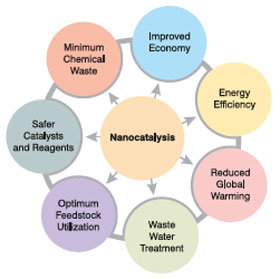- English
- فارسی
Nanocatalysts
Nanomaterial-based catalysts are usually heterogeneous catalysts broken up into metal nanoparticles in order to speed up the catalytic process. Metal nanoparticles have a higher surface area so there is increased catalytic activity because more catalytic reactions can occur at the same time. Nanoparticle catalysts can also be easily separated and recycled with more retention of catalytic activity than their bulk counterparts. These catalysts can play two different roles in catalytic processes: they can be the site of catalysis or they can act as a support for catalytic processes. They are typically used under mild conditions to prevent decomposition of the nanoparticles at extreme conditions.
Nanoparticle catalysts can be used in the hydrogenolysis of C-Cl bonds such as polychlorinated biphenyls. Hydrogenation of halogenated aromatic amines is also important for the synthesis of herbicides and pesticides as well as diesel fuel. In organic chemistry, hydrogenation of a C-Cl bond with deuterium is used to selectively label the aromatic ring for use in experiments dealing with the kinetic isotope effect. Buil et al. created rhodium complexes that generated rhodium nanoparticles. These nanoparticles catalyzed the dehalogenation of aromatic compounds as well as the hydrogenation of benzene to cyclohexane. Polymer-stabilized nanoparticles can also be used for the hydrogenation of cinnamaldehyde and citronellal. Yu et al. found that the ruthenium nanocatalysts are more selective in the hydrogenation of citronellal compared to the traditional catalysts used.

